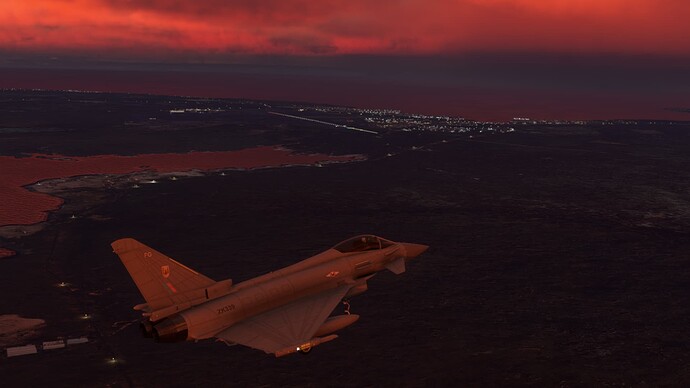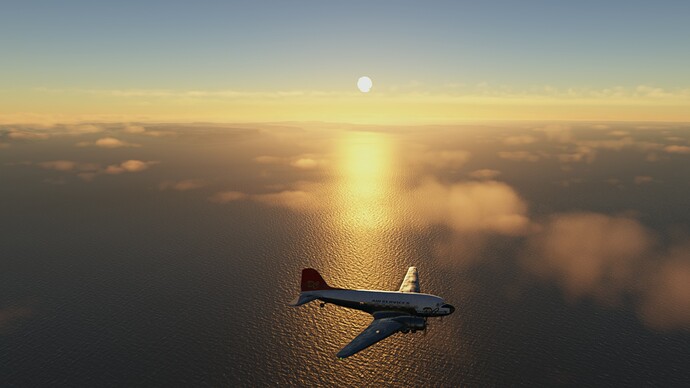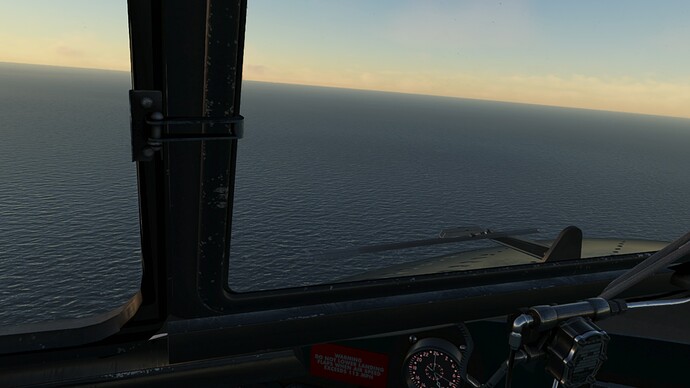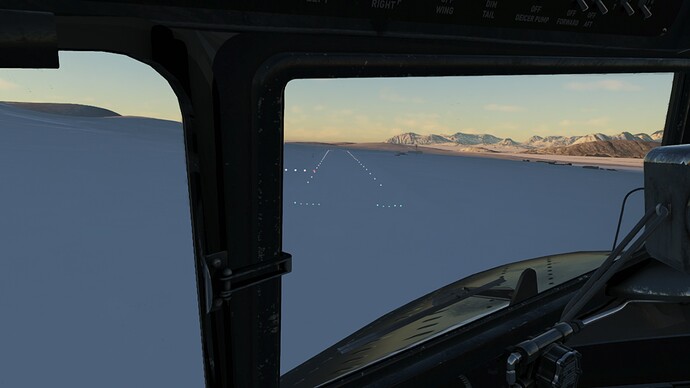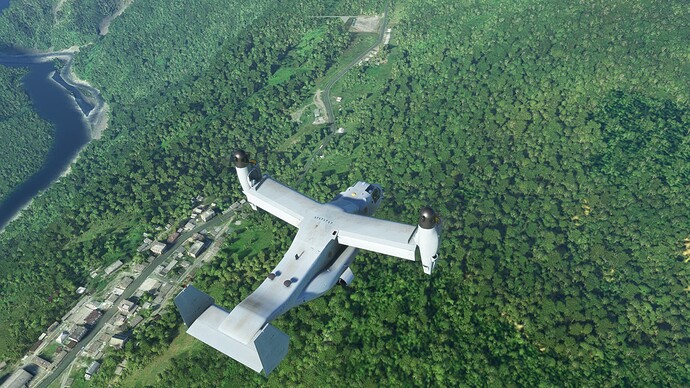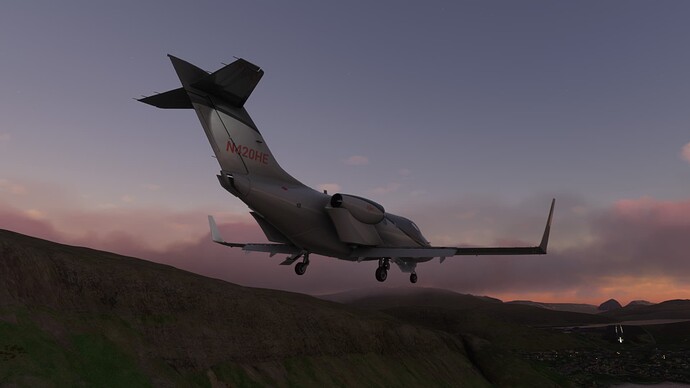How can you use rudder pedals incorrectly? ![]()
![]()
When left to ones own devices and no instruction on their proper use anything is possible. ![]()
Stepping on the ball instructions used to drive me bonkers because I had the rudders mapped backwards.
Works when you go sledding so why wouldn’t it work with rudder pedals… ![]()
Wheels
I guess like handlebars on a bike too now that I think about it. Still, reversing my rudder pedals would really mess me up!
Narsarsuaq Greenland to Keflavik Iceland.
I figured that if I wanted to get to the bar before @Deacon211 and @keets drank it dry, I had better get over there PDQ!
Conveniently there was a Typhoon sat on the ramp, which should do the job nicely!
The Typhoon is pretty spritely on the takeoff roll…
And climbs like a homesick angel, even with a full fuel load.
Super-Cruising along at M1.03 FL450.
At that speed, the transit to Iceland didn’t take long at all…Keflavik in sight.
On left base for Runway 01…
Down in one piece… now where is that bar we were all supposed to meet at?
Just checking back and I can see the last flight I did was more than one month ago ![]()
In the meantime, everyone is flying above my virtual head (I am sitting in Isafjordur in Iceland). So I put on a warm jacket and head towards a new bird in my hangar.
The plan is to fly from Isafjordur in Iceland to Kulusuk in Greenland, a trip about 343nm over water with not much NDB coverage. As explained in one of my posts above, I did not want to risk arriving to Greenland out of Kulusuk NDB range so I decided to use also the free GTN 750 and roughly half-way check the heading towards that NDB. For the rest of the flight, I would just rely on the NDB, compass and calculated wind correction angle.
Cold & Dark has a whole new meaning in Iceland ![]() Here I am ready to go. It is windy.
Here I am ready to go. It is windy.
Take off was pretty hairy but eventually I managed to establish some 500-1000 ft/min climb turning towards my intended heading of 290M.
En-route above the clouds. Just chilling out and checking the instruments time to time. Though I missed that I did not move the mixture levers to auto lean position after dialing in cruise power setting. Not a big deal as the mixture does not really work properly (yet) in this aircraft.
Not sure this is the Christmas cargo I loaded back in Iceland.
Flying with real time weather and season (not time though) means there is not much sunlight at these latitudes.
The cloud layer was slowly rising and was getting closer to my cruising altitude of 10k ft. I decided to get below it since I was also getting closer to my destination. De-icing on! (or the little that the DC-3 can offer)
This is how I came out below the cloud deck.
And once the ice cleared, I was greeted by clear weather ![]()

Greenland! I need to check where it got its name from. Waiting for the NDB to kick in.
Aaaaand here it comes, ladies and gentlemen! Some 30 degrees off on a distance of 38nm. Hm… could have been better. Half-way, I checked with the GTN 750 and corrected from 290M to 285M which was probably too aggressive.
Flying towards the field.
Above Kulusuk, turning right to join downwind.
And coming in for finals rwy 29.
On the apron ready to offload the weird cargo. No questions asked for the time being ![]()
I am happy to have the DC-3 in the sim. It still needs some polishing here and there but already now it is a very nice bird to fly. And recently Aeroplane Heaven released a first free livery pack. Make sure to get it from their webpage or from ORBX.
Recently we also got a C-47 in Il2 GB. I briefly jumped in to get a feel of the cockpit and…
…it feels very different to the DC-3 in MSFS. In VR, the cockpits feel having different sizes and various elements in the pit are also positioned differently and having different dimensions. Anyway, I take it as an artistic license and will enjoy flying them both ![]()
Next leg: Narsarsuaq, Greenland. Hopefully sooner than in one month.
You should have seen me land sailing in Denmark.
The land sailing vehicle has pedals to steer the front wheel, which suspiciously feel like rudder pedals, and thus make the piloting muscle memory kick in.
However they just transmit that movement into a rotation of the wheel, in order to make the ones with pedals act exactly like the more simple ones where you steer the wheel directly using your feet. Kite buggy drivers (who use the same vehicles, just without the sail) and land sailors are used to that.
So right pedal means going left.
The first few minutes were… special.
I’d wind up a fiery ball of wreckage within about ten seconds…and I’m pretty sure that thing isn’t even flammable! ![]()
Looks like fun though? But yeah, I’d probably be the lead story on the 6pm news as well!
It is indeed great fun! You can reach 1.5x wind speed or something. And other than the steering it is basically just like sailing an Optimist dinghy, I’d even say it is easier.
so many fast jets! I need one too ![]()
Delfín is definitely tad faster than CJ4 but I need moar.
in the ongoing XP sale I picked one candidate. she is fast and she is perfect in … our common pastime … steep approaches ![]()
(did you know there is terminus technicus for it !? so it isnt bad piloting, its called ‘Runway Dive’ ![]() NASA - T-38s Soar as Spaceflight Trainers )
NASA - T-38s Soar as Spaceflight Trainers )
I wont lie to you … I lied to you … some more Delfíns inbound ![]()
tested also Racing version, bit faster but very short legs
my happy place
We pickup the Xmas trek from our previous spot of Neiva Columbia.
Previously we had moved a crew of 7 vulcanologists from Bogota to Neiva in advance of picking up their equipment for transport to Reventador, Ecuador’s largest volcano. That is going to require some cargo space and lift capability. Something like a CH-47 or CH-53 would be ideal, we don’t happen to have one of those in MSFS simulator currently. Also there is some pretty high terrain to work around in the area (over 10,000’/3000m). Lastly it’s a fairly long distance from Neiva to Reventador, about 230 nm.
When you need the range and speed of a plane, and the ability to land in small places, you don’t have a lot of options. Fortunately there happened to be one of these handy…
The Miltech Simulations MV-22 Osprey. It’s a very good-looking model, that is being updated regularly currently. It is systems light, and to be honest is more of an Osprey “experience” than a simulator of the actual MV-22, based on what I have researched about the Osprey. With that said, it’s a really good “experience” that is very unique.
Take off is uneventful, fairly similar to a rotary running take off. Just with a lot more aircraft to handle. Nacelles can be at 90 for a vertical take off, 75 for a very STOL, or 60 for STOL operations. Apparently 45 degrees can be used for a running take off in the event of needing to go single engine or extremely bad density altitude conditions. I haven’t tried out the later yet.
We are currently using the livery of the VMM-263 “Thunder Chickens.” Orignally a CH-46 squadron, named the Thunder Eagles. Deploying to Vietnam, there is no Vietnamese word for Eagle, but there is Chicken. The rest is history. VMM-263 was also the first USMC squadron to combat deploy the MV-22 I believe.
Rolling the thumb wheel on the Thrust Control Level (TCL) forward or back adjust the nacelle angle in real time, via a pair of giant screws in the wing. The Osprey uses fly-by-wire systems to handle all this, preventing the pilot from doing anything that would damage the aircraft. Needless to say this isn’t the most popular thing with crews, as sometimes bending or breaking something is a better alternative.
Once conversion is complete, the Osprey is basically a small turboprop cargo airplane; and is flown as such.
The Osprey is non-pressurized, but equipped with supplementary oxygen for the flight crew. So getting over and around the Andes in this chunk would be doable real world, we might want to make provisions for the folks in the back to get a little O2 as well though.
In the next two screen shots you can see a lot of options are slashed through on the MFD’s, indicating they are not currently simulated. Miltech is very up front with what is working and what isn’t, so no complaints here I knew what I was buying. The MV-22 in the real world has the ability to plan and automatically fly a transition from airplane to vertical landing, the Miltech version does not. So we’re hand flying this, which is where it’s interesting.
Our landing spot is going to be the parking area located abeam the nose in this picture. Plenty of room, and no major hazards to get in or out.
An astute viewer will not we are in fact a different livery. I may or may not have wrapped up a few Ospreys getting the vertical landing part down…
Transitioning to vertical flight we are decelerating and setting up for landing. This where wrapping my head around the Osprey is still coming slowly. The Osprey can go from full forward flight to a dead hover in 1800m horizontal distance or so. I am still slowing down way to early, and having to crawl into my LZ. Which is preferable to descending too fast, getting into a vortex ring state and fireballing (not that this happened 5 or 6 times…).
Having a crew chief to call out altitudes would be very handy during landing, but I’ll make due with the radar altimeter. If you look the right most MFD you can see a red band on the VSI, this indicates the danger zone for vortex ring. Per the manual it’s supposed to be more than a 1500 FPM decent, you can see in the photo it’s at 500 FPM. I can tell you this version of the Osprey drops like a rock below about 600-700 FPM. I do not know which is correct the manual or the indicator, but for now fly the indicator.
Folding everything up like a nice christmas package.
Overall the Miltech MV-22 is a lot of fun to fly. There are a lot of system abstractions and things that are inop, but the main draw is V/STOL operations and it does this well. Learning to be able to cruise in, transition, and land the Osprey quickly and smoothly is going to take work. It is however rewarding when you do get it right.
I’d love to see sling loading, and NVG’s implemented at some point, as well as a little more fidelity in the engine control and modeling. Overall well worth what I paid for it.
Nice reports everyone! I was away for a week on a work trip, but I managed to get all caught up. I have a lot of my little hops completed and only about 10 more to reach my destination. Will try to file a report later today or over the weekend.
Iceland has consistently scored among the top 2 or 3 countries in the world when it comes to gender equity, as well as quality of life for parents in terms of healthcare, childcare, etc. I also remember reading something about the utter lack of stigma and offer of lots of services for single moms.
That is not at all what I got from that picture.

There’s also the part where the entire country has a population smaller than Raleigh, and there’s an app so folks can figure out if they’re related before they hook up. So there’s that.

Keflavik to Vagar, Faroe Islands.
Having recovered from the night before…it’s time to continue eastward. For this leg, I pulled the Honda Jet out of the virtual hangar.
Taxiing out to the runway, studying the airport chart while keeping half an eye on the Synthetic Vision display to keep me on the taxiway…what could possibly go wrong? ![]()
Tucking up the gear and turning out to the east…
Farewell Keflavik, it was fun while it lasted…
Iceland became much icier as I headed east…
Soon I was back over the ocean…
It wasn’t long before the Faroe Islands came into sight. I had set up for the RNAV approach to Runway 12.
There was a bit of a crosswind which made things interesting.
Down safely and shut down. I think I will head over to Sumburgh next.
In the UK, Iceland is a retail chain which sells frozen food. Typically at this time of year, there’s lots of Xmas adds with a celebrity tucking in to some type of party food.

Example….
The pic was a still from one of the adverts, their tagline was “That’s why Mum’s go to Iceland” because the food is very cheap.
@keets That’s disappointing. I really liked the @Navynuke99 explanation better ![]()
Iceland is on my bucket list of countries I really want to visit.
![]() That could have not been further from my interpretation. Thanks for explaining.
That could have not been further from my interpretation. Thanks for explaining.







